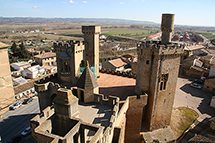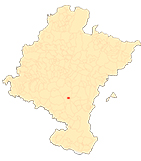The palace of Olite
Introduction
The Palace of Olite is the most important civil building from the medieval period still preserved in Navarre. It was built in response to the wish of King Charles III the Noble (1387-1425) to have an appropriate framework for the ideal of courtly life that he desired, in line with the French court's model . This monarch, born in Mantes, on the banks of the Seine, to a father and mother who belonged to the extensive French royal family, exemplifies like no other Hispanic sovereign of his time the figure of the artistic promoter of the so-called international style, that is, the exquisitely refined Gothic art that developed in the European courts around 1400. And it is his residency program olitense that provides the best insight into the sovereign's artistic will and ambition.
The king invested very large sums of money in his palace, which enabled him to hire first-class artists, both from Navarre and from neighbouring kingdoms, some of whom were hired in Paris. Work began around 1388 and was still being completed in 1424. They were directed by Martín Périz de Estella, the king's master builder. The abundant documentary references provide a variety of information about the craftsmen who formed part of teams of sculptors, painters, carpenters, plasterers, glaziers, etc., who were able to produce for the king whatever he requested. Their names are known: among others, the sculptors Johan Lome and Pedro Jalopa, the Tudela carpenter Lope Barbicano, the Aragonese painter Enrique de Estencop and the tapestry maker Lucien Bertolomeu.
Destroyed during the Spanish War of Independence, in the first decades of the 20th century, the aspiration to restore it materialised, which was finally undertaken in accordance with the project signed by the Yárnoz brothers, winners of the competition held in 1926. This intervention, carried out with criteria more typical of the 19th century, freely reconstructed the tops of several towers and canvases, which gave the palace an image different from that verifiable from documentary and graphic sources. Nevertheless, substantial parts of the palace are still standing, allowing us an experiential approach to the way of life of the royals in the late Middle Ages.












